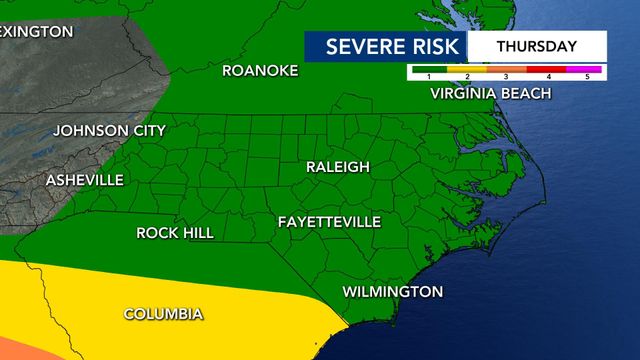How much damage can wind do? Hurricane categories and what they mean
How much damage can wind do? A lot. Strong winds can uproot trees, rip shingles and roofs from homes and buildings and leave wide swaths of customers without power.
Any severe thunderstorm can deliver wind damage -- it doesn't have to be during a tornado or hurricane. Below, take a closer look at hurricane categories, severe risk levels and how much damage various wind speeds associated with these risks can do.
Severe weather risks and what they mean
Often, a storm is just a storm, but when severe weather could threaten people or structures, the national Storm Predication Center (SPC) issues storm risks in levels 1 to 5, with Level 5 being the most severe.
Any thunderstorm could produce deadly lightning, gusty winds and small hail, but storms predicted to be severe are often ranked from Level 1 to Level 5. In North Carolina, Level 1 and Level 2 risks are the most common. Level 3 risks are more rare, and it is uncommon that a Level 4 or 5 risk is issued in our area.

Here's a look at what each risk level means and the damage storms can do.
Level 1: Marginal risk
Storms capable of damaging winds and severe hail. Localized tornadoes are possible. A Level 1 risk is very common, especially during warmer months.

Level 2: Elevated risk
An increased risk for damaging winds, severe hail and isolated tornadoes. A Level 2 risk is very common, especially during warmer months.

Level 3: Enhanced risk
High confidence that several storms will contain damaging winds, severe hail and/or tornadoes. A Level 3 risk is not as common, sometimes only issued once or twice a year, according to the SPC.
Category 4: Major risk
High confidence that many storms will contain damaging winds, severe hail and/or tornadoes. A Level 4 risk may occur in your area less than once a year or even less, according to the SPC.
Category 5: Extreme risk
High confidence that an outbreak of storms will contain tornadoes, damaging winds and/or severe hail. Someone might witness a Category 5 risk once or twice in their lifetime, according to the SPC.
Hurricane categories and what they mean
In any thunderstorm and especially during tornadoes and hurricanes, wind speed dictates the severity of a storm and how much damage wind can do.
The Saffir-Simpson Hurricane Wind Scale is used by the National Weather Service (NWS), meteorologists and emergency management to prepare for and respond to hurricanes. Category 1 is considered a minimal hurricane, while a Category 5 hurricane carries the greatest risk for wind damage. Categories 3 to 5 are defined as major hurricanes, according to the NWS.
How much damage can wind do?
Wind can cause a lot of damage. The National Hurricane Center (NHC) created a moving graphic showing how different categories impact homes and trees.
Hurricanes are assigned categories based on their severity, but what is the difference between Category 1 and Category 5?
Category 1: Winds 74-95 mph
Storm damage can be fairly minimal with a Category 1 hurricane compared to major hurricanes, but even well-built homes could see storm damage, and trees could be uprooted.
Winds during a Category 1 storm are still dangerous, and roofs, shingles, vinyl siding and gutters could all be damaged on homes and buildings.
According to the NHC, "large branches of trees will snap and shallowly rooted trees may be toppled. Extensive damage to power lines and poles likely will result in power outages that could last a few to several days."
Category 2: Winds 96-110 mph
In a Category 2 storm, the damage is more extensive. Siding can be pulled away from the home, flying debris can break windows and trees could bend and break.
There could be extensive damage to homes, including roof and siding damage. Many shallowly rooted trees will be snapped or uprooted and block numerous roads. According to the NHC, "near-total power loss is expected with outages that could last from several days to weeks."
Category 3: Winds 111-129 mph
A Category 3 hurricane could cause the door of a house to blow in due to stronger winds. A home's roof could become dislodged, and trees could begin to fall.
The NHC calls the damage of a Category 3 storm "devastating." Uprooted trees could block roads, and electricity and water could be unavailable for several days to weeks after the storm passes.
Category 4: Winds 130-156 mph
A Category 4 storm will cause even more devastating damage. Windows could break, shingles could fly away and exterior walls and roofs could even fly away.
According to the NHC, "Most trees will be snapped or uprooted and power poles downed. Fallen trees and power poles will isolate residential areas. Power outages will last weeks to possibly months. Most of the area will be uninhabitable for weeks or months."
Category 5: Winds 157 mph or higher
A Category 5 storm produces catastrophic damage, with walls falling and no trees left standing.
According to the NHC, a "high percentage of framed homes will be destroyed, with total roof failure and wall collapse. Fallen trees and power poles will isolate residential areas. Power outages will last for weeks to possibly months. Most of the area will be uninhabitable for weeks or months."










